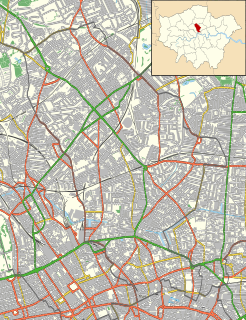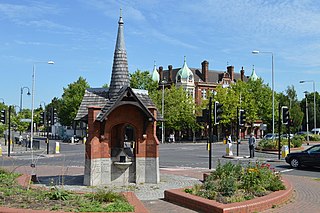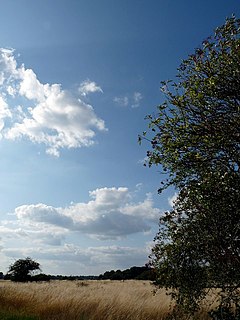
Wanstead Hall was the manor house for the Manor of Wanstead, now in the London Borough of Redbridge but historically in the county of Essex. It was later demolished to make way for the construction of Wanstead House.

Wanstead Hall was the manor house for the Manor of Wanstead, now in the London Borough of Redbridge but historically in the county of Essex. It was later demolished to make way for the construction of Wanstead House.

It was probably quite a small building until the 14th century, but by 1499 it was large enough to serve as a royal hunting-lodge, when it was acquired by King Henry VII, one of whose favourite resorts it was to become. [2] Henry had developed a taste for privacy towards the end of his reign, and acquired Wanstead as a maison de retraite in the vicinity of Greenwich Palace, laying out considerable sums on it. It was valued by him especially for its park, bringing the King much needed seclusion. [3] Henry VII used Wanstead as a location for receiving payments from what the Tudor historian David Starkey calls his "slush fund" of extra-parliamentary taxation and fines, away from the eyes of the magnates in the formal royal palaces. [4] The young future Henry VIII lived for a while at Wanstead and at the other maison de retraite of Hanworth Manor in enforced proximity to his father Henry VII during the last years of his reign. [5] Both kings hunted within the manor.
It was during Henry VIII's reign (1509–1547) that Wanstead Park was inclosed, shortly before 1512, which probably involved the clearance of some wooded areas. At about this time neighbouring Aldersbrook became a separate manor. Wanstead remained a Royal manor for a number of years, its "keeper" being an office awarded to favoured royal courtiers, one after another. Hugh Denys (d.1511) Groom of the Stool to Henry VII was its keeper until 1511, being one of the King's key financial officers who often received the "slush fund" monies there on the King's behalf. On Denys's death in 1511 the keepership passed to Charles Brandon, later Duke of Suffolk and from 1515 Henry's brother-in-law via marriage to his sister Mary Tudor. [6]
Sir John Heron, another former financial officer within the Privy chamber, was keeper of the park until his death in 1521. Heron also held lands in Aldersbrook and it is said that he brought heron birds to the area, as an amusing mark of his presence. One of the lakes was historically known as "Herony (sic) Lake". (A heronry, i.e. colony of heron birds, is shown on Lincoln Island on a 1919 OS map of Wanstead Park, unless this is merely a confusion over the nomenclature of the lakes.) Lord Richard Rich, High Chancellor of England, was keeper of the park in 1543, and in 1549 Edward VI granted him the lordship of the manor of Wanstead, complete with the park. In 1577 Rich's son Robert sold it to Robert Dudley, 1st Earl of Leicester, who purchased the nearby manor of Stonhall in Ilford at the same time. Thereafter a succession of owners kept the manor of Wanstead combined with Stonehall.

King James hunted at Wanstead on 24 September 1609 and gave an audience to the Venetian ambassador Marc' Antonio Correr, who he described as a Pantalone. [7] He stayed again in September 1614 giving an audience to another Venetian diplomat Antonio Foscarini. [8]
In 1619 Sir Henry Mildmay was in possession, but forfeited the manor to the Crown at the end of the Civil War, in which he had fought for Parliament. Charles II granted the estate to his brother, James, Duke of York, but it was restored in about 1662 to Sir Robert Brooke, Mildmay's son in law. In 1673-4 the manor was purchased by Josiah Child, Governor of the East India Company. He spent much time and money in developing the estate according to the fashion of the time and was created 1st Baronet Child of Wanstead in 1678.
When John Evelyn, the diarist, visited Wanstead in March 1683 he wrote: "I went to see Sir Josiah Child's prodigious cost in planting walnut trees about his seate, and making fish ponds many miles in circuit in Epping Forest, in a barren place." [9] The ponds mentioned by Evelyn still exist, though somewhat altered, forming a chain of ponds descending from the Shoulder of Mutton Pond, through Heronry Pond, Perch Pond, the Dell and into the Ornamental Waters.
Child died in 1699, and was succeeded by his son – also Sir Josiah Child – who leased Wanstead and Stonehall to his half-brother, Richard Child. On Sir Josiah II's death in 1704, Richard Child became 3rd Baronet, having succeeded to his title and estates [10] – eleven years later he commissioned the design for the Hall's replacement, Wanstead House.

Canonbury is a residential area of Islington in the London Borough of Islington, North London. It is roughly in the area between Essex Road, Upper Street and Cross Street and either side of St Paul's Road.

Wanstead is a town in East London, England, in the London Borough of Redbridge. It borders South Woodford to the north, Redbridge to the east and Forest Gate to the south, with Leytonstone and Walthamstow to the west. It is located 8 miles northeast of Charing Cross.

Sir Josiah Child, 1st Baronet,, was an English economist, merchant and politician. He was an economist proponent of mercantilism and governor of the East India Company. He led the company in the Anglo-Mughal War.

Henry, Duke of Cornwall was the first living child of King Henry VIII of England and his first wife, Catherine of Aragon, and though his birth was celebrated as that of the heir apparent, he died within weeks. His death and Henry VIII's failure to produce another surviving male heir with Catherine led to succession and marriage crises that affected the relationship between the English church and Roman Catholicism, giving rise to the English Reformation.

The Groom of the Stool was the most intimate of an English monarch's courtiers, responsible for assisting the king in excretion and hygiene.

Wanstead Flats is the southernmost portion of Epping Forest covering Leytonstone and Wanstead, London. The flats and by extension the forest ends at Forest Gate directly to the south. It now falls wholly within the boundaries of London Borough of Redbridge and London Borough of Waltham Forest, though until 1994 two parts of it were in the London Borough of Newham - one of these was the section between Aldersbrook Road and Capel Road east of the junction between Aldersbrook Road and St Margaret's Road, whilst the other was the strip running along Capel Road between its junctions with Centre Road and Ridley Road. As part of Epping Forest, the flats is managed by the City of London Corporation.

Wanstead Park is a municipal park covering an area of about 140 acres, in Wanstead, in the London Borough of Redbridge. It is also a district of the London Borough of Redbridge, which was in Essex until 1965. The park is bordered to the north by the A12 road, to the east by the River Roding and A406 North Circular Road, to the south by the Aldersbrook Estate, the site of the former Wanstead Sewage Works and the City of London Cemetery and Crematorium and to the west by Wanstead Golf Course. It is administered as part of Epping Forest by the City of London Corporation, having been purchased by the Corporation in 1880 from Henry Wellesley, 1st Earl Cowley. Today's park once formed part of the deer park of the former manor house of ancient Wanstead Manor, which included much of the urbanised area now known as Wanstead. The present park retains some of the layout of its former existence as Wanstead House's grounds, though the park's western boundary lies some 330 yards east of the house's site. In 1992 a Management Plan was initiated to try to re-establish something of the formality of the grounds of a "Great House".

Pishiobury, sometimes spelled Pishobury, was a manor and estate in medieval Sawbridgeworth, Hertfordshire. Its denomination as "Pishiobury" only emerged in the mid to late 19th century.

Wanstead House was a mansion built to replace the earlier Wanstead Hall. It was commissioned in 1715, completed in 1722 and demolished in 1825. Its gardens now form the municipal Wanstead Park in the London Borough of Redbridge.
Woking Palace is a former manor house of the Royal Manor of Woking on the outskirts of Woking, near the village of Old Woking, Surrey.

Cockfield Hall in Yoxford in Suffolk, England is a Grade I listed private house standing in 76 acres (31 ha) of historic parkland, partly dating from the 16th century. Cockfield Hall takes its name from the Cokefeud Family, established there at the beginning of the 14th century. It was purchased by Jon Hunt in 2014 to form part of his Wilderness Reserve offering exclusive rural holiday accommodation.

In medieval and Early Modern England, Wales and Ireland, a deer park was an enclosed area containing deer. It was bounded by a ditch and bank with a wooden park pale on top of the bank, or by a stone or brick wall. The ditch was on the inside increasing the effective height. Some parks had deer "leaps", where there was an external ramp and the inner ditch was constructed on a grander scale, thus allowing deer to enter the park but preventing them from leaving.
Sir William Compton was a soldier and one of the most prominent courtiers during the reign of Henry VIII of England.
Sir Henry Mildmay was an English politician who sat in the House of Commons at various times between 1621 and 1659. He supported the Parliamentarian cause in the English Civil War and was one of the Regicides of Charles I of England.
Hugh Denys of Osterley was a courtier of Kings Henry VII and of the young Henry VIII. As Groom of the Stool to Henry VII, he was one of the King's closest courtiers, his role developing into one of administering the Privy Chamber, a department in control of the royal finances which during Denys's tenure of office also gained control over national fiscal policy. Denys was thus a vital player in facilitating the first Tudor king's controversial fiscal policies.

Richard Child, 1st Earl Tylney, was an English politician who sat in the House of Commons between 1708 and 1734. Initially a Tory, he switched to supporting the Whigs after 1715. He held no Office of State, nor any commercial directorship of significance, but is remembered chiefly as the builder of the now long-demolished Palladian "princely mansion" Wanstead House, one of the first in the style constructed in Britain. In the furnishing of his mansion Child became the main patron of the Flemish painter Old Nollekens. He died in March 1750 aged 70 at Aix-en-Provence, France, and was buried on 29 May 1750 at Wanstead.
Sir Robert Brooke was an English landowner, magistrate, commissioner, military officer, knight and MP who sat in the House of Commons from 1660 to 1669. Dying at the age of 32, his promise was cut short, and the core of his estates in East Suffolk passed by marriage into the Blois family.

Wimbledon manor house; the residence of the lord of the manor, was an English country house at Wimbledon, Surrey, now part of Greater London. The manor house was over the centuries exploded, burnt and several times demolished. The first known manor house, The Old Rectory was built around 1500 still stands as a private home, despite very nearly falling into a state beyond repair, in the 19th century. The ambitious later Elizabethan prodigy house, Wimbledon Palace, was "a house of the first importance" according to Sir John Summerson, and is now demolished.

Dogmersfield Park or Dogmersfield House is a Grade I listed Georgian country house, now being used as a hotel. It is located in Dogmersfield, a small village in Hampshire, England. The land was recorded in the Domesday Book of 1086 as "Doccemere feld".
Wanstead Roman Villa was a Roman villa on an unknown site in what is now Wanstead Park. Archaeological excavations carried out in 1985 indicated a Roman presence here from the 1st to the 5th century AD, but did not locate any specific site of a Roman villa.
| Wikimedia Commons has media related to Wanstead Hall . |